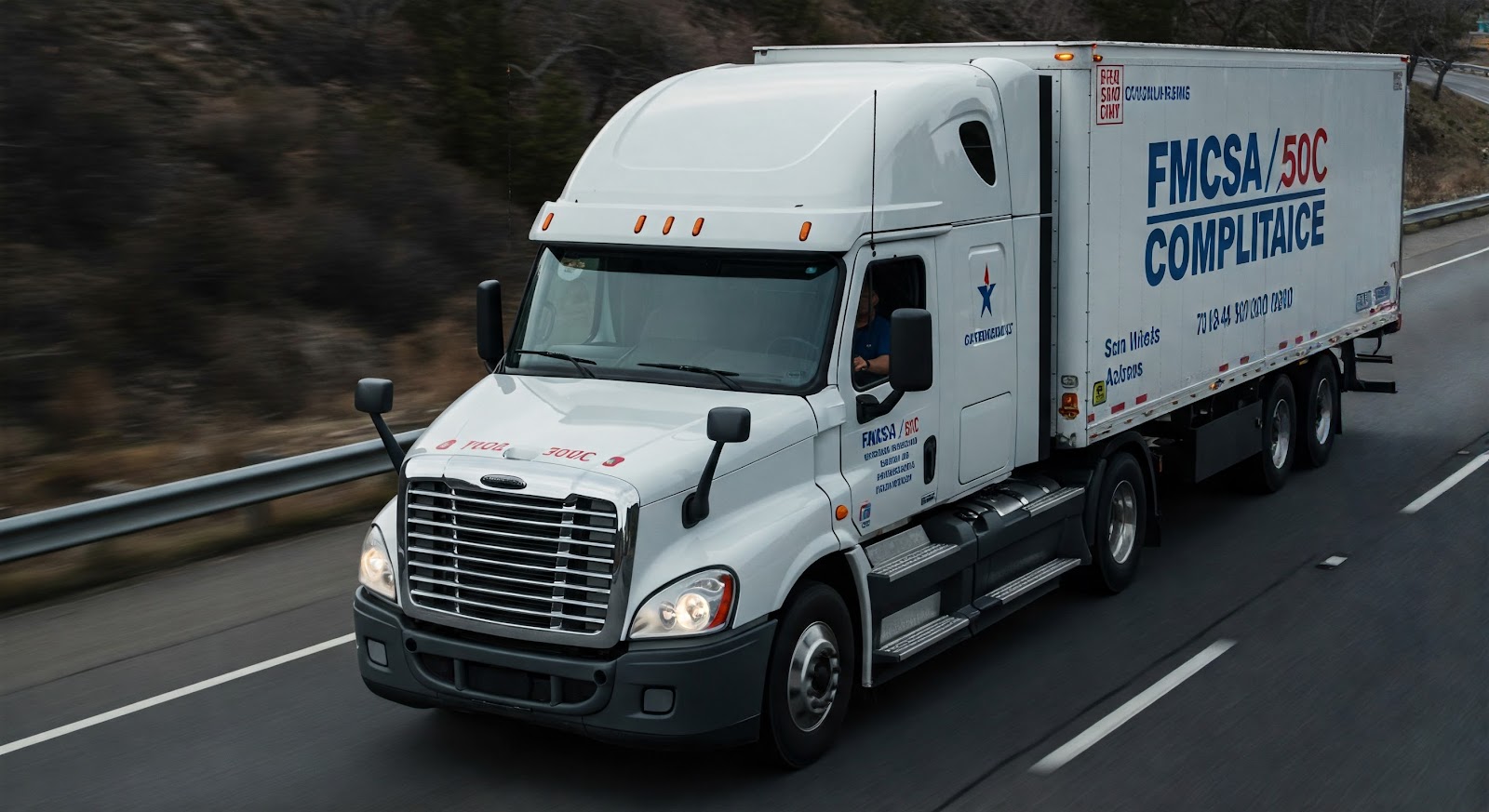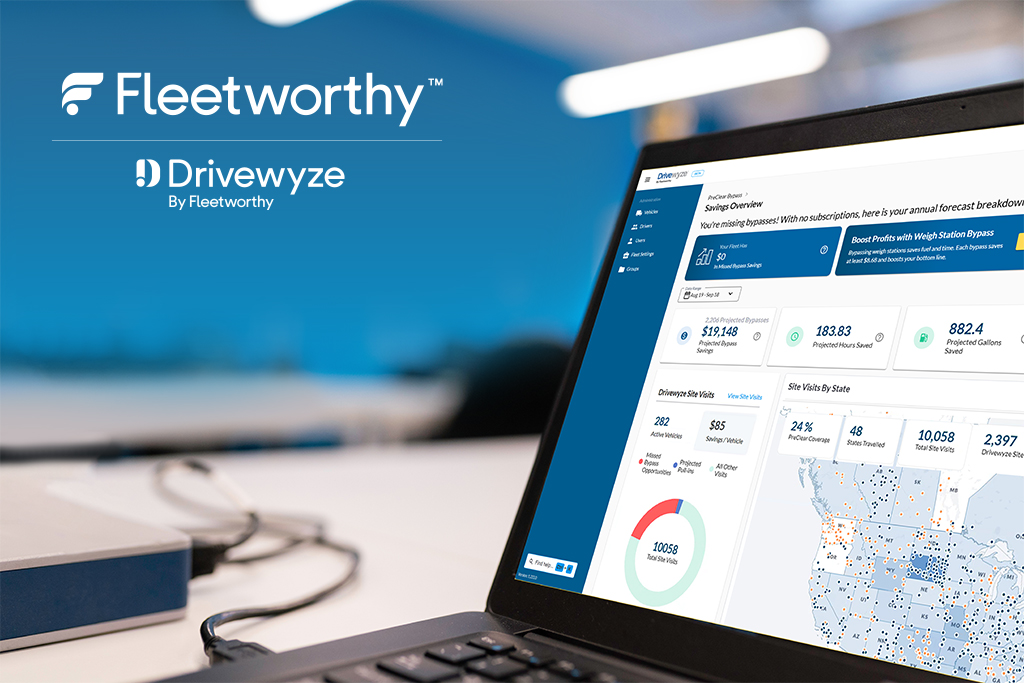FMCSA (Federal Motor Carrier Safety Administration) compliance is fundamental to the transportation industry, ensuring that commercial motor vehicles (CMVs) operate safely and legally. By setting strict regulations for drivers, carriers, and vehicles, FMCSA compliance plays a key role in reducing accidents, maintaining road safety, and ensuring that transportation companies meet federal requirements.
Ensuring Safety and Legal Compliance in Transportation
Adhering to FMCSA regulations is more than just a legal requirement—it’s a crucial aspect of maintaining a well-functioning and responsible transportation system. These regulations cover various aspects of operations, from driver qualifications and hours-of-service (HOS) compliance to vehicle inspections and maintenance.
Key Benefits of FMCSA Compliance:
- Accident Prevention: By enforcing strict safety standards, FMCSA compliance helps mitigate the risks of accidents caused by fatigue, poor vehicle maintenance, or unqualified drivers.
- Driver and Public Safety: Regulations ensure that commercial drivers are properly trained, well-rested, and medically fit to operate large vehicles, reducing hazards on the road.
- Avoidance of Fines and Penalties: Non-compliance can lead to hefty fines, operating suspensions, and loss of business opportunities.
- Improved Fleet Efficiency: Compliant fleets experience fewer delays, improved safety ratings, and reduced liability risks.
Key Aspects of FMCSA Compliance
To maintain compliance, carriers must focus on several critical areas:
1. Driver Qualification Standards
- All CMV drivers must meet specific requirements related to age, licensing, and medical fitness to operate safely.
- Companies must maintain Driver Qualification (DQ) Files, including employment history, safety performance records, drug and alcohol test results, and medical examiner certificates.
- Regular drug and alcohol testing is required for safety-sensitive positions, including pre-employment, random, post-accident, and return-to-duty testing.
2. Hours-of-Service (HOS) Compliance
- FMCSA Hours-of-Service (HOS) rules regulate the number of hours a driver can operate a vehicle before mandatory rest breaks.
- Key HOS rules include:
- 11-hour driving limit after 10 consecutive hours off-duty.
- 14-hour maximum on-duty limit per day.
- 30-minute mandatory break after 8 hours of driving.
- 60/70-hour weekly limits with a 34-hour reset option.
- Electronic Logging Devices (ELDs) are required to automate HOS tracking and ensure compliance with driving limits.
3. Vehicle Maintenance and Inspection Protocols
- FMCSA mandates that carriers implement a Preventative Maintenance Program (PMP) to keep CMVs in safe operating condition.
- Daily Driver Vehicle Inspection Reports (DVIRs) must be completed by drivers before and after each trip.
- Carriers are responsible for Periodic Vehicle Inspections (Annual DOT Inspections) to verify that vehicles meet safety standards.
- Failure to maintain vehicles properly can result in out-of-service violations and increased liability in accidents.
4. Hazardous Materials (HazMat) Handling
- Strict regulations govern the transportation of hazardous materials, requiring:
- Special training for drivers handling HazMat loads.
- Proper labeling, packaging, and documentation.
- Emergency response plans for incidents involving hazardous substances.
- Non-compliance with HazMat regulations can lead to severe fines and suspension of operating privileges.
5. Safety Audits and FMCSA Inspections
- New carriers must undergo a New Entrant Safety Audit within the first 12 months of operation.
- Carriers with poor safety records are subject to Compliance Reviews (CRs) and intervention measures under the FMCSA Compliance, Safety, and Accountability (CSA) program.
- FMCSA assigns Safety Measurement System (SMS) scores, which impact a carrier’s ability to operate and secure contracts.
6. Insurance and Financial Responsibility Requirements
- FMCSA requires motor carriers to maintain adequate insurance coverage, including:
- Public liability insurance (minimum coverage varies by vehicle type and cargo).
- Cargo insurance for freight protection.
- General liability insurance to cover third-party claims.
- Insurance non-compliance can result in the revocation of operating authority.
The Importance of FMCSA Compliance for CMV Operators
FMCSA compliance is not just a bureaucratic requirement—it directly impacts the safety, efficiency, and reputation of carriers. Non-compliance can lead to significant penalties, including fines, out-of-service orders, and even company shutdowns.
Consequences of Non-Compliance:
- Financial Penalties: FMCSA violations can result in fines ranging from hundreds to thousands of dollars per infraction.
- Legal Liability: Non-compliance can increase liability exposure in accidents and lawsuits.
- DOT Audits & Increased Scrutiny: A poor safety record can trigger more frequent inspections and compliance reviews.
- Loss of Operating Authority: Severe violations may lead to the revocation of FMCSA registration and business closure.
On the other hand, prioritizing compliance benefits carriers by:
- Reducing risk of fines and penalties.
- Improving CSA scores, making it easier to secure contracts.
- Increasing driver retention and satisfaction.
- Enhancing operational efficiency through proactive safety measures.
Best Practices for Maintaining FMCSA Compliance
To remain compliant and avoid violations, transportation companies should implement a structured compliance program:
1. Establish a Compliance Management System
- Regularly review FMCSA regulations and update policies accordingly.
- Use fleet management software to automate compliance tracking, including HOS logging, vehicle inspections, and driver records.
2. Conduct Regular Internal Audits
- Periodically audit driver qualification files, HOS logs, and maintenance records.
- Identify and correct compliance gaps before FMCSA inspections.
3. Invest in Driver Training and Education
- Provide ongoing training on FMCSA regulations, defensive driving, and HOS management.
- Encourage drivers to report safety concerns and violations.
4. Implement Robust Vehicle Maintenance Programs
- Schedule routine maintenance checks and track vehicle service history.
- Use telematics and diagnostic systems to monitor vehicle performance.
5. Monitor Compliance Metrics and CSA Scores
- Regularly check FMCSA’s Safety Measurement System (SMS) to track safety performance.
- Address rising CSA scores before they lead to interventions.
Understanding and maintaining FMCSA compliance is crucial for CMV operators, as it directly affects road safety, legal standing, and operational success. Compliance involves more than just meeting regulatory requirements—it’s about fostering a culture of safety that benefits drivers, companies, and the public.
Hours of Service (HOS) Regulations: Preventing Driver Fatigue
Driver fatigue is a leading cause of accidents involving commercial trucks, often resulting in severe injuries or fatalities. HOS rules help mitigate these risks by structuring work-rest cycles, limiting the number of hours a driver can operate, and enforcing mandatory breaks. These measures not only protect truck drivers but also safeguard the general public from the dangers of overworked and fatigued drivers.
To ensure compliance and accuracy, HOS rules are enforced through Electronic Logging Devices (ELDs), which automatically track driving and rest hours. These devices have replaced traditional paper logs and reduce the possibility of falsified records or errors in tracking hours.
Breakdown of Key HOS Regulations
HOS regulations set strict limits on driving and on-duty hours to prevent overexertion. Below are the core components of the HOS framework:
1. 11-Hour Driving Limit
- Rule: A driver may drive a maximum of 11 hours after taking 10 consecutive hours off duty.
- Purpose: This rule prevents drivers from staying on the road for excessively long stretches without adequate rest.
- Impact: Limiting the number of driving hours reduces mental fatigue, slow reaction times, and impaired decision-making.
2. 14-Hour Workday Limit
- Rule: A driver cannot drive more than 14 consecutive hours after starting a work shift.
- What It Includes: This 14-hour window includes both driving time and all other on-duty activities, such as loading, unloading, inspections, and fueling.
- Rest Period Requirement: The 14-hour work window can only begin after 10 consecutive off-duty hours.
- Why It Matters: The 14-hour rule prevents drivers from extending their work shifts indefinitely, ensuring they have a set period of off-duty time to rest before their next shift.
3. 30-Minute Mandatory Break
- Rule: If a driver has accumulated 8 consecutive hours of driving time, they must take a break of at least 30 minutes before continuing to drive.
- Break Activities: The 30-minute break can be off-duty, in sleeper berth, or on-duty but not driving.
- Purpose: Short rest breaks help drivers stay alert and focused, reducing risks of drowsiness and microsleeps while driving.
4. 60/70-Hour Weekly Driving Limit
- Rule: Drivers cannot be on duty for more than:
- 60 hours in a 7-day period (for carriers operating 6 days per week).
- 70 hours in an 8-day period (for carriers operating 7 days per week).
- Resetting the Clock: Drivers can reset their weekly driving hours by taking a 34-hour consecutive off-duty period (commonly referred to as the 34-hour restart rule).
- Why It’s Important: These weekly limits prevent long-term fatigue buildup and promote a more structured work-rest schedule.
Enforcing HOS Compliance: The Role of ELDs
Since December 2017, the FMCSA has mandated the use of Electronic Logging Devices (ELDs) for nearly all commercial drivers to enforce HOS compliance.
Benefits of ELDs:
- Accurate tracking: Eliminates manual errors and falsified logs.
- Real-time monitoring: Provides up-to-date driving and resting time.
- Improved efficiency: Reduces administrative work by automating log management.
- Compliance assurance: Helps carriers avoid costly violations and penalties.
Failure to comply with ELD requirements or HOS regulations can result in severe penalties, including:
- Fines ranging from hundreds to thousands of dollars per violation.
- Lower CSA (Compliance, Safety, and Accountability) scores, affecting business operations.
- Potential suspension of operating authority for repeat violations.
Challenges and Solutions for HOS Compliance
Common Challenges:
- Unrealistic Schedules by Carriers – Some companies pressure drivers to exceed HOS limits to meet delivery deadlines.
- Driver Fatigue Mismanagement – Even when compliant, some drivers do not utilize rest periods effectively.
- Misinterpretation of Rules – Some drivers and fleet managers struggle to understand exceptions, such as short-haul exemptions.
Best Practices for Staying Compliant:
- Educate drivers on HOS rules – Conduct training sessions to ensure they understand their limits and rights.
- Leverage ELD technology – Use automated logging to track compliance effortlessly.
- Encourage proper rest habits – Promote a culture of safety and well-being in the organization.
- Schedule realistic routes – Plan deliveries within HOS limits to prevent violations.
By preventing driver fatigue, these regulations help reduce the number of accidents caused by exhaustion and overwork.
Understanding Driver Qualification Requirements for FMCSA Compliance
Ensuring that commercial motor vehicle (CMV) drivers meet strict qualification standards is a fundamental responsibility for transportation companies. The Federal Motor Carrier Safety Administration (FMCSA) has established driver qualification regulations to ensure that only well-trained, medically fit, and legally eligible individuals operate commercial vehicles. These requirements are not only essential for road safety but also play a crucial role in FMCSA compliance and liability reduction for motor carriers.
For carriers, understanding and maintaining driver qualification records is essential to avoid penalties, enhance fleet safety, and prevent legal issues. Below is a comprehensive breakdown of FMCSA driver qualification requirements and the key documents that must be maintained.
Core Driver Qualifications: Meeting FMCSA Standards
To qualify as a CMV driver, individuals must meet specific FMCSA requirements in the following key areas:
1. Age and Licensing Requirements
- Minimum Age:
- Drivers operating a CMV interstate must be at least 21 years old.
- For intrastate operations, some states allow drivers as young as 18.
- Commercial Driver’s License (CDL):
- Drivers must hold a valid CDL appropriate for the vehicle class and cargo type.
- Some specialized CMVs require additional endorsements (e.g., hazardous materials, passenger transport).
- Proof of Licensing:
- Employers must verify and document the driver’s CDL and any necessary endorsements.
2. Medical Certification & Physical Fitness
- DOT Medical Certification:
- All CMV drivers must undergo a medical examination by a certified DOT-approved medical examiner.
- If medically fit, the driver is issued a Medical Examiner’s Certificate (MEC), which is valid for up to 2 years.
- Some medical conditions (e.g., diabetes, hypertension) may require more frequent evaluations.
- FMCSA’s National Registry of Certified Medical Examiners (NRCME):
- Employers must ensure that medical exams are conducted by an examiner listed in the NRCME.
- Failure to Maintain Certification:
- If a driver’s medical certification expires, they are disqualified from operating a CMV.
3. Road Tests and Driving Experience
- FMCSA Road Test Requirement:
- New CMV drivers must pass a road test conducted by a motor carrier or certified examiner.
- Successful drivers receive a Road Test Certificate, which must be kept on file.
- Equivalent Experience:
- In some cases, a CDL holder with verifiable experience may be exempt from taking a road test.
- Acceptable alternatives include a valid CDL with the proper endorsements or a certificate from a truck driving school.
4. English Language Proficiency
- Regulation Requirement:
- Drivers must be able to read, write, and speak English sufficiently to:
- Understand traffic signs and signals.
- Communicate with enforcement officials.
- Complete required reports and documentation.
- Drivers must be able to read, write, and speak English sufficiently to:
- Why It’s Important:
- Limited English proficiency can impact safety and compliance, potentially leading to violations.
5. Drug and Alcohol Testing Compliance
- Pre-Employment Drug Screening:
- FMCSA requires all new drivers to pass a drug test before beginning employment.
- Ongoing Testing Requirements:
- Carriers must conduct random, post-accident, and reasonable suspicion drug and alcohol testing.
- Drivers who fail drug tests must complete a Return-to-Duty (RTD) process before resuming driving duties.
Best Practices for FMCSA Driver Qualification Compliance
To stay compliant with FMCSA regulations, carriers should implement the following best practices:
1. Standardize Hiring and Onboarding Procedures
- Verify CDL, endorsements, and MVR history before hiring.
- Ensure drivers pass pre-employment drug tests.
- Complete and maintain a full Driver Qualification (DQ) File.
2. Conduct Regular Compliance Audits
- Review DQFs quarterly to check for missing or expired documents.
- Schedule MVR checks and medical certificate updates proactively.
3. Implement Automated Compliance Management
- Use fleet management software to track driver qualifications, license expirations, and medical renewals.
- Automate reminders for required updates to prevent compliance lapses.
4. Prioritize Ongoing Driver Training
- Educate drivers on FMCSA qualification requirements and compliance policies.
- Offer refresher training on medical certification, safety regulations, and drug testing policies.
By thoroughly vetting drivers and maintaining up-to-date qualification records, transportation companies can avoid costly penalties, reduce liability risks, and improve overall fleet safety.
Drug and Alcohol Testing Protocols: Ensuring a Safe and Compliant Workforce
The Role of Drug and Alcohol Testing in Transportation Safety
Substance abuse among CMV operators poses severe risks—not only to drivers but also to passengers, other road users, and the transportation company itself. Testing programs serve as a proactive measure to detect and deter drug and alcohol use, reinforcing a culture of safety, responsibility, and accountability within the industry.
Comprehensive Overview of Drug and Alcohol Testing Programs
To ensure compliance with FMCSA regulations, employers must implement a drug and alcohol testing program that includes six types of mandatory tests:
1. Pre-Employment Testing
Requirement:
- Before hiring, all CMV drivers must pass a DOT-mandated drug test.
- Employers cannot allow a driver to operate a commercial vehicle until a negative test result is received.
Purpose:
- Prevents substance abusers from entering safety-sensitive positions.
- Establishes a drug-free standard from the outset of employment.
Key Considerations:
- Pre-employment alcohol testing is not required, but carriers may choose to implement it.
- If a driver has been out of the workforce for 30+ days, a new pre-employment drug test is required.
2. Random Testing
Requirement:
- CMV drivers are subject to random, unannounced drug and alcohol testing throughout the year.
- FMCSA sets an annual minimum testing rate that carriers must follow:
- Drug tests: 50% of the workforce per year.
- Alcohol tests: 10% of the workforce per year.
Purpose:
- Deters drug and alcohol use by making testing unpredictable.
- Encourages ongoing compliance with FMCSA regulations.
Key Considerations:
- Employers must use a scientifically valid selection method to ensure fairness.
- Testing must be conducted immediately after notification to prevent evasion.
3. Reasonable Suspicion Testing
Requirement:
- If a trained supervisor observes signs of drug or alcohol impairment, the driver must immediately undergo testing.
Purpose:
- Detects and removes impaired drivers from service before accidents occur.
- Reinforces company commitment to a drug-free workplace.
Key Considerations:
- Supervisors must complete FMCSA-approved training to identify:
- Slurred speech, erratic behavior, poor coordination.
- The smell of alcohol or drugs.
- Bloodshot eyes, drowsiness, or signs of withdrawal.
- Documentation of the observed behavior is mandatory before testing.
4. Post-Accident Testing
Requirement:
- A driver must be tested for drugs and alcohol if they are involved in an FMCSA-reportable accident that results in:
- Fatality (mandatory).
- Injury requiring immediate medical treatment (if driver cited).
- Disabling vehicle damage requiring towing (if driver cited).
Purpose:
- Determines whether substance use was a factor in the accident.
- Ensures accountability and provides legal protection for the company.
Key Considerations:
- Alcohol testing must be conducted within 2 hours (no later than 8 hours).
- Drug testing must be conducted within 32 hours after the accident.
- Employers must document any reason for delay or inability to test.
5. Return-to-Duty (RTD) Testing
Requirement:
- Drivers who fail a drug or alcohol test must complete a substance abuse evaluation and treatment program before being allowed to return to safety-sensitive duties.
- Before returning to duty, the driver must pass a DOT-mandated RTD test.
Purpose:
- Provides an opportunity for rehabilitation while ensuring that only sober, compliant drivers return to work.
Key Considerations:
- Testing must be directly observed.
- The driver cannot resume normal duties until they pass the test.
6. Follow-Up Testing
Requirement:
- After passing Return-to-Duty testing, a driver must undergo unannounced follow-up tests for at least 12 months.
- The Substance Abuse Professional (SAP) determines the number of follow-up tests (minimum of 6 tests over 12 months).
Purpose:
- Ensures continued sobriety and compliance after returning to duty.
- Acts as a deterrent against repeat offenses.
Key Considerations:
- Follow-up testing is in addition to random testing requirements.
- If a driver fails any follow-up test, they must restart the RTD process.
Strengthening Workplace Safety Through Drug & Alcohol Testing
A robust testing program fosters a culture of safety and accountability within a transportation company. By enforcing drug and alcohol testing:
- Employees are less likely to work under the influence, reducing accident risks.
- It discourages substance abuse and promotes responsible behavior.
- Fleet efficiency improves, ensuring safer operations and fewer violations.
- Carrier reputation is enhanced, reinforcing public trust in the transportation industry.
Drug and alcohol testing protocols are not just regulatory requirements—they are essential safety measures. FMCSA’s strict guidelines help carriers protect their workforce, avoid costly violations, and contribute to overall road safety.
Leveraging Educational Resources for FMCSA Compliance
There are several valuable resources available to support continuous FMCSA compliance education. Companies should leverage a combination of online and in-person training to ensure all employees receive comprehensive, up-to-date compliance instruction.
1. Online Training Programs
- Offer convenient and flexible learning that allows drivers and fleet managers to train at their own pace.
- Cover topics like HOS compliance, driver qualification requirements, drug and alcohol testing, and fleet safety best practices.
- Available through FMCSA-approved training providers, industry associations, and compliance platforms.
2. Workshops and Seminars
- Provide hands-on, interactive learning experiences led by industry experts and FMCSA representatives.
- Allow participants to ask questions, discuss real-world compliance challenges, and receive immediate feedback.
- Cover a wide range of topics, including CSA score management, audit preparation, and new FMCSA rule updates.
3. FMCSA Website and Publications
- The FMCSA website serves as the primary source of official regulatory information.
- Provides access to guidance documents, regulatory updates, safety advisories, and training materials.
- Offers downloadable resources such as FMCSA handbooks, HOS rule summaries, and inspection checklists.
4. Compliance Software and Learning Platforms
- Help companies integrate training and compliance tracking into daily operations.
- Provide real-time updates on regulatory changes to ensure immediate compliance adjustments.
- Offer automated reminders for required actions, such as driver qualification file updates and random drug testing schedules.
- Enable fleet managers to track employee training progress and identify areas for improvement.
5. Industry Associations and Professional Groups
- Organizations like the American Trucking Associations (ATA), Commercial Vehicle Safety Alliance (CVSA), and National Safety Council (NSC) offer certification programs, training materials, and networking opportunities.
- Membership in FMCSA-endorsed groups ensures companies receive first-hand updates on regulatory changes.
- Webinars, conferences, and publications help businesses stay ahead of compliance challenges.
How Companies Can Integrate Education into Their Compliance Strategy
To ensure continuous FMCSA compliance, companies should actively incorporate educational resources into their compliance management plan. Here’s how:
1. Establish a Formal Training Program
- Develop a structured FMCSA compliance training curriculum for new hires and current employees.
- Offer refresher courses every 6-12 months to ensure employees stay updated on new regulations and best practices.
- Assign training based on job roles, ensuring drivers, fleet managers, and compliance officers receive appropriate instruction.
2. Require Regular Compliance Training for Drivers
- Implement mandatory FMCSA compliance training as part of driver onboarding and annual safety meetings.
- Cover critical topics, including HOS rules, pre-trip inspections, drug testing procedures, and FMCSA audits.
- Use quizzes and real-world scenarios to assess understanding and retention..
3. Utilize Compliance Software for Training Management
- Invest in fleet management and compliance tracking software that automates training assignments and regulatory updates.
- Use digital dashboards to monitor employee progress and identify knowledge gaps.
- Provide on-the-go mobile learning options for drivers who travel frequently.
4. Encourage a Culture of Continuous Learning
- Make FMCSA compliance training an ongoing priority, rather than a one-time event.
- Recognize and reward employees who demonstrate a commitment to compliance education.
- Encourage staff to attend industry conferences, participate in webinars, and read FMCSA publications.
Stay FMCSA Compliant with Fleetworthy
At Fleetworthy, we provide industry-leading compliance management tools and expert guidance to help your fleet stay road-legal, reduce risks, and optimize operations. From automated driver qualification tracking to vehicle maintenance management and audit support, our solutions are designed to keep your fleet safe & compliant.
- Simplify FMCSA compliance with automated record management
- Reduce risk and fines with proactive monitoring and reporting
- Improve fleet efficiency with data-driven insights and real-time tracking
Take the stress out of FMCSA compliance—partner with Fleetworthy today!Contact us now to learn more about our compliance solutions or schedule a demo to see how Fleetworthy can help your fleet operate smarter and safer!




